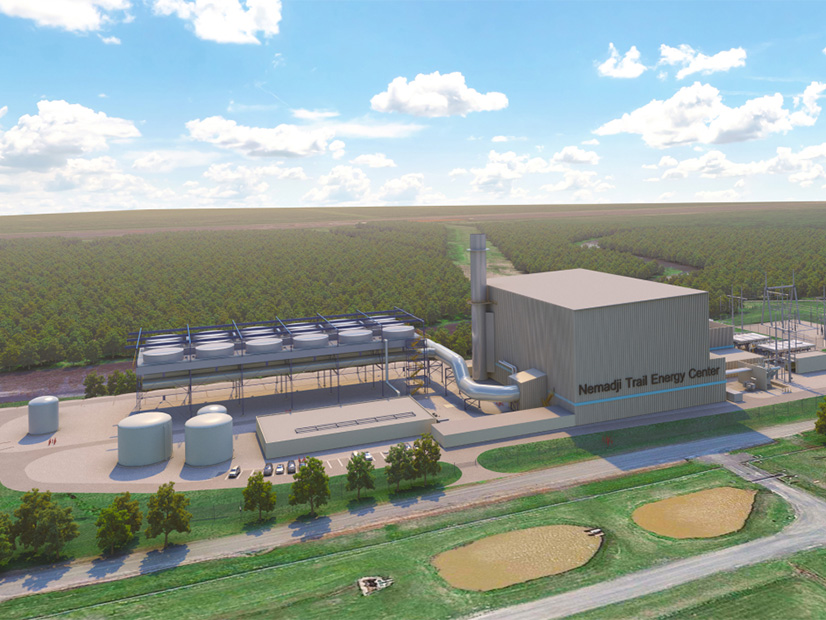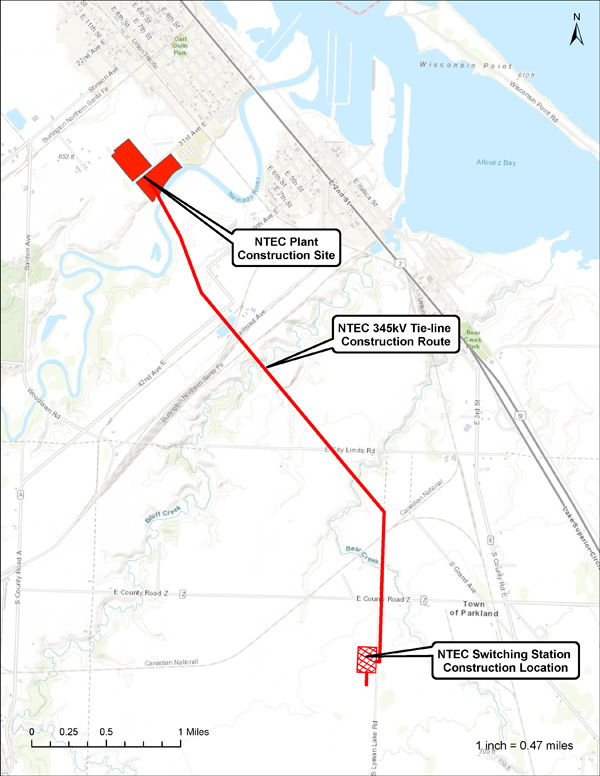
The timeline for building the Nemadji Trail Energy Center (NTEC) in Wisconsin has been pushed into next year as clean energy groups continue to challenge the need for the planned gas-fired plant.
Minnesota Power, Dairyland Power Cooperative and Basin Electric Power Cooperative filed an update with the Public Service Commission of Wisconsin to report that onsite relocation work on the $700 million plant in Superior, Wis., won’t begin until April. Work was originally slated to begin in the third quarter of this year (9698-CE-100).
The utility and cooperatives now say the 625-MW NTEC won’t reach commercial operation until 2028 — not March 2027, as anticipated in the last update in July.
Dairyland said the holdup is a result of permitting, litigation and supply chain delays. In an email to RTO Insider, Dairyland spokesperson Katie Thomson said delays could drive up the cost of the project and risk grid reliability.
NTEC still needs a wetland permit from the U.S. Army Corps of Engineers and a stormwater permit from the Wisconsin Department of Natural Resources.
The slowdown comes as the Sierra Club and Clean Wisconsin continue to argue that the plant is harmful and unnecessary.
The two environmental groups this year asked the Wisconsin PSC to reopen the docket and rescind its 2020 approval of the plant. They also appealed a 2022 decision on their lawsuit alleging that the PSC failed to consider the full environmental impact of the plant (2020CV000585).
Last year, Dane County Circuit Judge Jacob Frost upheld the regulators’ approval of NTEC and said the PSC followed the law when issuing a certificate of public convenience and necessity, though he acknowledged the “massive impacts a major project of this nature holds for the state.”
In its 2020 decision, the Wisconsin PSC concluded that renewable energy combined with battery storage was “not yet capable of replacing a plant of this size.”
But the two groups argue that the planned construction of 489 MW in battery projects in Wisconsin will be complete a few years before NTEC is slated to begin running and is enough to negate the need for the plant.
They also continue to insist that the utility and cooperatives didn’t sufficiently analyze alternatives before settling on the gas plant. The groups maintain the cooperatives should instead pursue some of the $9.7 billion in federal funding available through the Inflation Reduction Act to help rural electric cooperatives transition from fossil fuels to renewable generation.
The groups say customers will be paying to recover the costs for NTEC at least into the 2050s, past the end date of most net-zero carbon pledges.
This year, Clean Wisconsin attorney Brett Korte said the PSC has a chance to reconsider the plant “to protect ratepayers and the environment by recognizing that the energy landscape has fundamentally changed since 2020.”
“This plant was always a bad investment, but it would be incredibly unwise to leave so much money on the table and stubbornly stick with fossil fuels that are going to harm communities and the environment in Wisconsin. The new federal funding really is a game changer, and Wisconsin should do everything it can to capitalize on the opportunities it presents,” Korte said.
Superior Mayor Jim Paine has changed his tune on the plant, saying it’s no longer needed. In a July letter commenting on a revised supplemental environmental assessment by the Department of Agriculture’s Rural Utilities Services, Paine said his “change of heart, mind and spirit” boils down to Dairyland’s acquisition of the 503-MW RockGen Energy Center gas plant in 2021, the ramp-up of renewable energy and energy storage, and a belief that the NTEC site is ill-suited for industrial development.
Construction will require the developers to fill in about 20 acres of wetlands on the banks of the Nemadji River. It would also be located near indigenous mass burial grounds.
The Sierra Club said NTEC would be located “at the top of a steep slope with a historically high risk of erosion, potentially causing stormwater runoff.” The group pointed out that the utilities estimate they will have to pump almost three million gallons of water daily to operate the plant, close to the total daily water usage of the City of Superior itself.
Four of the Superior City Council’s 10 members — Nicholas Ledin, Jenny Van Sickle, Garner Moffat and Ruth Ludwig — also submitted letters of opposition. The council passed a resolution in favor of the plant in 2019.
Dairyland Says Plant is Crucial
Dairyland insists the plant is necessary to fill lulls in renewable energy output, delivering a bridge to a zero-carbon future. It also said the plant could be retrofitted to operate on up to 30% hydrogen.
“Today, there are not commercially available, utility-scale long-term battery storage technologies on the market to meet current and anticipated energy requirements,” Thomson said. “Currently, battery storage simply does not have the ability to replace the 24/7 power generated by power plants. A battery supplies energy measured in hours between charges, whereas a power plant supplies reliable energy for days, weeks or even months when wind and solar are unable to meet the demand for electricity.”
However, Thomson added that Dairyland is “enthusiastic” about batteries and other forms of energy storage and noted the co-op is exploring pumped hydro storage in abandoned mines and was recently awarded a battery storage grant from the Department of Energy.
She said NTEC’s ramping capability will help support Dairyland’s planned portfolio of 12 new wind and solar projects totaling 1.7 GW that could be funded under the IRA’s Empowering Rural America program, the same $9.7 billion program the Sierra Club and Clean Wisconsin urged the cooperatives to pursue.
Thomson said NTEC will dependably supply power at “60% less carbon, 100% less mercury and 97% less other emissions than coal.”
Clean Wisconsin has said rather than reducing emissions, the plant will annually release 3 million tons of carbon pollution into the environment.
The plant would operate as a merchant generator selling power in MISO markets. The RTO last year commented in support of the plant to the Rural Utilities Service, saying it would welcome new gas-fired capacity to bolster resource adequacy in its footprint. (See MISO Executives Spotlight Fleet Evolution Planning, Risks.)



